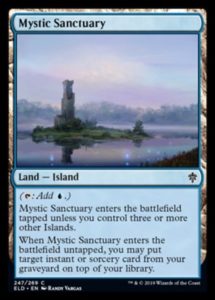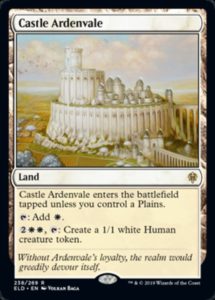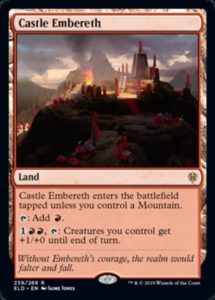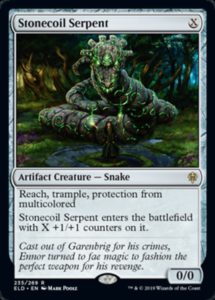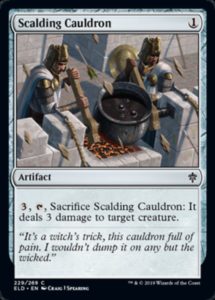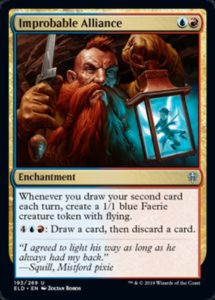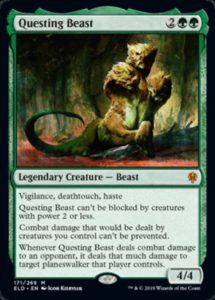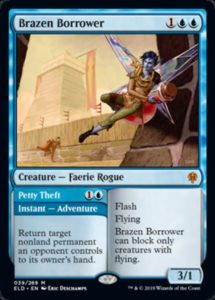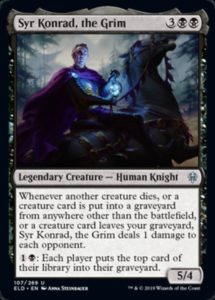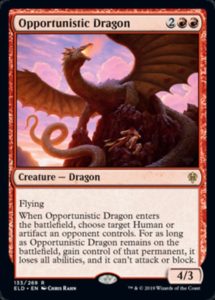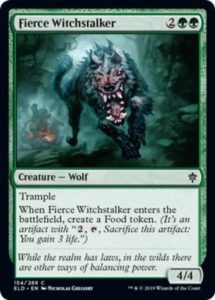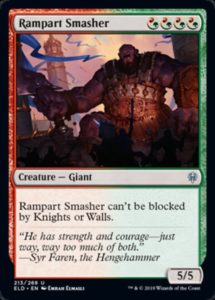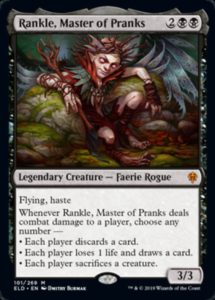Throne of Eldraine prerelease is in the rear view mirror. The set releases this weekend, and that’s when lots of folks (yours truly included) will flock to MagicFest Montreal (some of us for former columnist Hugh Kramer’s bachelor party, but that’s a story for another day and another author).
Now that we’ve played with the cards, let’s take a bit of time to consider their designs. Throne of Eldraine is a fascinating new type of thematic design, since it’s chock full of both Arthurian legends (which Magic draws upon so frequently that they’re harder to notice) and fairy tales (which is the opposite case and these less numerous cards are much more prominent parts of the set). We’ve never seen this hybridized top-down take on two different real world mythologies/folklores; and it’s relatively rare that we see such an emphasis on monocolor play, especially in Limited—only Shadowmoor and Theros have heavily played in this space (okay, and Onslaught, but that was more a consequence of how color-limited its tribes were). So, let’s get to the cards already!
Unprecedented Lands
Magic has been playing in some more dangerous design spaces: just in Throne of Eldraine, we see a new and incredibly flexible wish (Fae of Wishes), a big mana ritual (Irencrag Feat), a free spell (Once Upon a Time), and two cycles of powerful lands (one of which is fetchable). All of these feel like the outgrowth of Play Design—Eldraine was designed when the team was more than a year old and had stretched its legs, so they likely felt capable of playing with fire and not getting burned. While it’s surprising seeing references to so many overpowered cards of yore, it’s impressive seeing Play Design thread the needle over and over. It’s better for Magic to experiment, take risks, and occasionally ban cards rather than play things too safe. Moreover, these aren’t the kinds of risks seen in Smuggler’s Copter, Emrakul, the Promised End, and Hazoret the Fervent, where creatures were increasingly pushed to the breaking point—this is a variety of boundary-tests. Time will tell whether any of these cards go too far, but it’s exciting seeing Magic bravely experiment.
Oh, right, the cards themselves! The Mystic Sanctuary cycle is really cool. Whereas previously we’ve seen cards like Teetering Peaks and Mortuary Mire that always function in a specific way (which sometimes you have no use for) and always enter the battlefield tapped, this cycle either does nothing and comes into play tapped or does everything. That’s a very cool way to reference the monocolor subgame of Adamant and to reward dedicated deckbuilding.
Then, there’s the rare cycle. We’ve seen cards like Contested War Zone, Nykthos, Shrine to Nyx, and Kjeldoran Outpost play in this vein before and this cycle looks pretty outstanding next to its forebears. The cost of putting them into a Constructed deck isn’t super high (especially with shocklands in Standard) and they all provide so much power. Yet, at the same time, they’re expensive enough to use that they’re not a guaranteed boon to control and aggro decks, and they really punish you for also playing Temples. Castle Vantress might be too slow to be a huge boon to control decks, Castle Lochthwain has a huge life cost, and Castle Garenbrig is extremely specific in its effect. It’s Castle Ardenvale and Embereth that seem particularly powerful, since they provide the kinds of effects that aggro decks want and have the least cost (since so many aggro decks can be monocolor).
Well, this is a total bomb in Limited, since it’s above-rate at every spot on the curve. Yes, the abilities seem a bit random, but this is a less a top-down slam dunk and more a Constructed role player. This exists to support monocolor aggressive decks of all shapes and stripes. It certainly doesn’t look like the next Smuggler’s Copter, but there’s a reason that Play Design has to be super careful about powerful colorless cards.
Flamecast Wheel was an essentially unplayable uncommon. Scalding Cauldron seems like the perfect balance of mediocrity and playability. You’re more than likely than not to play it, but it doesn’t undercut red, black, and white’s removal. It’s also more essential than normal for there to be potent colorless removal since Adamant encourages players to commit more heavily to a single color, thereby reducing their access to the removal of a support color. Jousting Dummy is another excellent example of a tiny bit of power creep—Bronze Sable was truly awful, but with an expensive bit of Firebreathing and a relevant creature type, plenty of decks have a replacement-level curve filler in a moncolor-friendly format where such cards are more necessary. These little powerups quietly do a lot of work to enable decks and it’s worth taking a brief stanza to sing their praises.
I adore this card. Not only is the flavor absolutely silly, but in the right deck, this is Bitterblossom with upside and no downside (or Mistbind Clique shenanigans). I love uncommon enchantment engines; and while this certainly fits the bill, I worry that this is perhaps too potent at uncommon (but that’s a Play Design concern, not a game design one).
Questing Beast is an easy kind of card to make fun of—it has a ridiculous six abilities, some of which seem fairly random or tacked on. It’s also a significant character in the lore of the world, but this doesn’t tell the story of a beast that gives out mighty quests.
I’m kind of fine with it. Standard needs powerhouse midrange creatures, and Questing Beast fights a slew of strategies all at once and without providing card advantage. It has two pairs of three abilities, which at least relates to its three heads. Sure, it has basically trinket text disallowing certain kinds of damage prevention, but that’s a lot less dangerous on a four drop creature than on Narset, Parter of Veils. Taken as a whole, Questing Beast is big, brutal, and deserving of its mythic status. But, while we’re on the subject…
Brazen Borrower doesn’t really feel mythic. It clearly harkens back to two potent spells, Vendilion Clique and Nimble Obstructionist. Nimble Obstructionist cast Stifle, a very iconic spell, and was merely a rare. Vendilion Clique does something that no other blue card does and remains a multi-format all-star. Brazen Borrower combines a worse Disperse with a better Cloud Spirit. Sure, that’s clearly potent, but there’s nothing here that terribly excites me beyond how obviously powerful the combination of the two is.
I know that “what qualities define a mythic” debate simmers and occasionally boils over. Brazen Borrower is another card that reminds players that games are commodities that need to make their creators money. The thing that makes it feel particularly strange is Syr Konrad, the Grim. He’s our next card, so we’ll continue the discussion there.
Syr Konrad feels like he was plucked from Dominaria, alongside Tatyova, Benthic Druid and Garna, the Bloodflame that would have been rare or even mythic in another set. (Keeper of Fables gets my second vote for the “How is this not a rare?!” award.) The set of abilities look almost ludicrous on one card—basically, if you’re saying the words “creature” and “graveyard” in a sentence, Syr Konrad flicks your opponent’s nose. He’s a one-card win condition in board stalls and can even turn a losing race into an impossible situation.
It’s cool seeing Magic has learned from Dominaria that more complicated and powerful cards can be put at uncommon. However, this shines a Glaring Spotlight on cards like Brazen Borrower that feel like they were upshifted in rarity despite their low complexity. Yes, Magic needs to sell booster packs and part of that comes from workhorse mythics that lots of players need, but Syr Konrad and Brazen Borrower might be too stark a reminder that mythic is just a label and one that involves dollars.
Opportunistic Dragon is a weird bend for red. It’s not a color pie break, since red’s weakness is neither Humans (which tend to be small, burnable creatures) nor artifacts (which red is best at destroying). Red can gain control of things (but until now, only temporarily) but has no access to Arrest-style effects. All together, this looks a whole lot like a white card (the only color that gets Banishing Light effects).
The big question I have is why this card needed to be put into the set. It doesn’t seem to fill a necessary Constructed slot for red. Sure, this new take on Hoarding Dragon can capture a Beloved Princess or Charming Prince, but it’s a very weird direction to bend red. Perhaps we’ll be seeing more of this effect; but if it’s not the harbinger of things to come, I do wonder why it ended up printed.
This mirrored pair of green four drops communicate a trend that I wish I could see more and less of. I love that green gets four mana 4/4 with upside that also engage with a set mechanic. They’re the midrange glue that holds green together in Limited—without them, cards like Prey Upon lose much of their potency—and each of them feels specific to their location because they utilize a set mechanic. Compare this with Rampart Smasher—sure, the blocking restriction is somewhat specific to Eldraine, but so often the red-green signpost uncommon is just an undercosted, overstatted beater with some minor evasion ability that’s mostly agnostic.
I would love to see more Bolrac-Clan Crushers, Grumgully, the Generouses, and Immerwolfs and fewer Khenra Charioteers, Outland Boars, and Sunder Shamans that aren’t at all specific to their planes or Limited environments.
While there are plenty of worthy cards to discuss (especially Bake into a Pie, Wicked Guardian, and Heraldic Banner), I don’t think I could pick a better card to conclude with than Rankle, Master of Pranks. Rankle feels like the Spikiest card in years. He offers a ton of power, but there’s a huge ceiling to it and only the most skilled players will be able to recognize exactly what modes are the best options every turn of the game.
If you connect with an opponent, you have eight options to choose from (choose everything, choose nothing, choose one of his three abilities, or choose one pair of abilities out of three possible pairs). That’s a wealth of possibilities, and the relative merits can shift based on the board state, players’ hand sizes and life totals, and the matchup. And all of that is wrapped up in the very appropriate package of a capricious fairy king (that’s too busy being a rogue to bother with being a noble).
And that’s where we’ll end things today (okay, fine, I’m cheating and using Heraldic Banner as my favorite card of the month so I can talk about it, too). Hopefully you’ve enjoyed this dive into the set and are enjoying the really cool and usual Limited format it contains—I know I am.
And, as always, thanks for reading.
—Zachary Barash is a New York City-based game designer and the commissioner of Team Draft League. He designs for Kingdom Death: Monster, has a Game Design MFA from the NYU Game Center, and does freelance game design. When the stars align, he streams Magic (but the stars align way less often than he’d like).
His favorite card of the month is Heraldic Banner. It combines mana ramp/fixing (which normally controlling and goodstuff decks want) with a color-specific anthem (which is what monocolor aggressive decks want). There’s a lot of power there, but it presents a deckbuilding puzzle for players to find a solution to. It’s also the perfect kind of puzzle to include in Throne of Eldraine, since the format is defined by finding balance among ambitious monocolor mana requirements. And okay, it also works perfectly with Unlikely Alliance.

